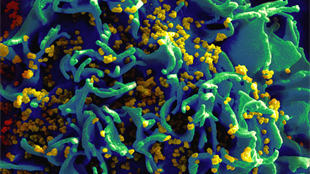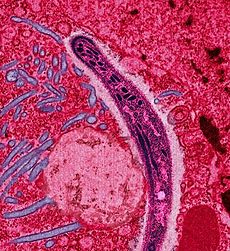Scientists extracted a near-complete HIV-1 genome from a lymph node that had been preserved in wax for more than 50 years. The sample stands as the oldest HIV-1 genome yet recovered, predating the previous oldest sample by a decade, the researchers reported July 1 on the preprint server bioRxiv.
The HIV-1 virus was first discovered in 1983, 17 years after the contaminated lymph node was collected from a 38-year-old man in Democratic Republic of Congo, according to News-Medical.Net. Upon removing the sample, pathologists fixed the tissue in formalin and embedded it in wax before stowing it away for about half a century. Many tissue samples of this type were archived in hopes of better understanding the then-unknown disease, notes The Atlantic.
Coauthor Michael Worobey and his colleagues discovered the lymph node, no larger than a fingernail, while combing through more than 1,600 tissue samples at the University of Kinshasa in search of HIV genome fragments. Among the plentiful samples, only the lymph node contained traces of the virus, according to The Atlantic. The preservation process left the RNA torn and ragged, but the team managed to extract and assemble enough fragments to form a near-complete genome.
“It turns out that you can retrieve [RNA] more than 50 years later, even if the thing has been sitting in a drawer at ambient temperature. Which can be pretty warm in Kinshasa,” says Worobey, who studies the evolutionary origin of pathogens at the University of Arizona, in an interview with The Atlantic. “Just on that sequence, we’ve been plugging away for more than five years,” he adds in an interview with News-Medical.Net.
HIV samples recovered from 1959 and 1960 indicated that the virus was present in the region long before its discovery, but little RNA could be recovered from either sample, The Atlantic reports. The 1966 genome resembles the most prevalent HIV subtype, called C, but appears to be a cousin to that group of viruses.
“There are very sophisticated evolutionary models you can use to trace back what has happened through history, but they’re still models. With old genetic material, you can see what reality was actually like,” adds coauthor Sophie Gryseels, a postdoc in Worobey’s lab, in an interview with The Atlantic.
The team held up the virus against evolutionary models of the HIV lineage, which scientists reverse-engineered from modern data and piecemeal evidence of ancestral genomes. The researchers found that the modeled timeline nearly aligned with theirs: they estimate that the virus originated in Central Africa between 1896 and 1905, while previous evaluations placed the date around the 1920s.
“Although its discovery doesn’t substantially alter our current model of the early genetic history of the AIDS pandemic, it does improve our confidence in conclusions previously drawn from modern and partial HIV gene sequences,” says Oliver Pybus, a professor of evolution and infectious diseases at the University of Oxford, in an interview with News-Medical.Net.
The near-complete genome should further scientists’ understanding of which factors drove the emergence of HIV and later led to the HIV/AIDS pandemic, the authors suggest.
“Why are we interested in fossils? Because they tell a story,” Beatrice Hahn, who investigates the evolution of HIV at the University of Pennsylvania Perelman School of Medicine, tells The Atlantic. “This HIV ‘fossil’ is no different. It’s an important piece in the evolutionary puzzle.”







